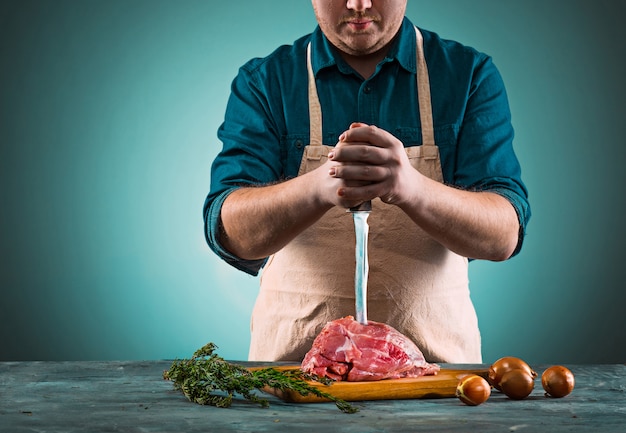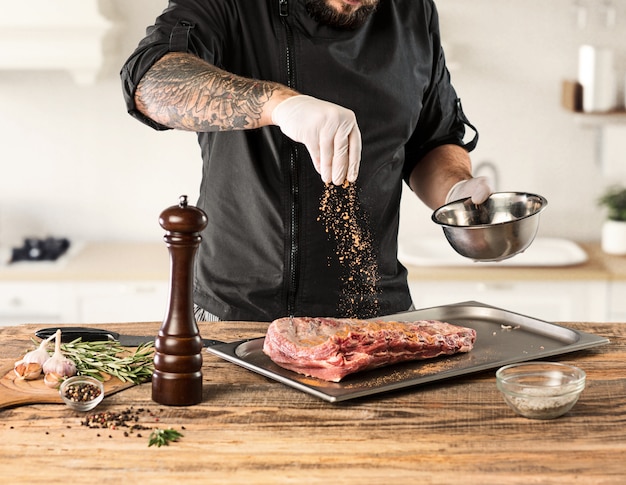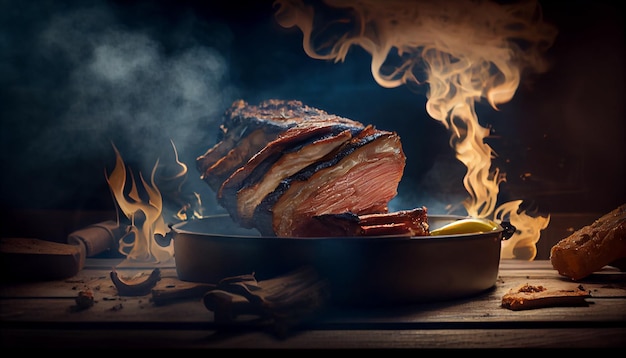We've all been there, right? You've spent hours in the kitchen, prepping and cooking a delicious meal. The aroma of sizzling meat fills the air, and your taste buds are tantalized. But then, as you slice into the juicy steak or roast chicken, a flicker of doubt creeps in. Is it really cooked through? That pink tinge in the middle - is it safe to eat? The anxiety starts to gnaw, and suddenly, all the excitement around that delicious meal evaporates.
Don't worry, you're not alone. Many of us have battled with the "did it cook?" dilemma, especially when it comes to meat. The truth is, nobody wants to risk food poisoning, particularly when you've poured your heart and soul into a culinary masterpiece. In this comprehensive guide, I'll share my experiences, insights, and practical tips to help you cook meat safely and deliciously, with confidence and peace of mind.
(Part 1) food safety: The Cornerstone of Cooking

Understanding the Invisible Threat: foodborne bacteria
Before we dive into the nitty-gritty of cooking, let's first grasp the importance of food safety. Raw meat can harbor nasty bacteria like Salmonella, E. coli, and Campylobacter, which can cause food poisoning. These microscopic culprits are invisible to the naked eye, but their effects can be quite unpleasant.
Imagine this: you take a bite of what seems like a perfectly cooked piece of chicken, and the next day you're struck with a sudden wave of nausea, diarrhoea, and stomach cramps. This is food poisoning in action. While it's usually manageable and symptoms clear up within a few days, it can be particularly dangerous for vulnerable individuals like children, the elderly, or people with weakened immune systems.
The Importance of Cooking: Eradicating the Threat
Cooking meat thoroughly is your weapon against these invisible enemies. The heat from cooking destroys these harmful bacteria, making your meal safe to eat. But it's crucial to understand that simply browning the outside of the meat isn't enough. You need to ensure that the internal temperature reaches a safe level to kill off all the bacteria.
(Part 2) The "Cooked Through" Myth-Busting Mission

The Pinkness Myth: Debunking a Common Misconception
For years, we've been told that a little pinkness in meat is acceptable. "It's just rare, it's perfectly fine," we've heard. Well, I'm here to tell you, that's a myth! While the colour of the meat can be an indicator, it's not a reliable one. Some cuts of meat, like beef, can have a pink tinge even when they're thoroughly cooked, while others, like chicken, might appear to be cooked through but still harbor harmful bacteria.
The meat thermometer: Your Reliable Ally
So, what's the solution? How do you know for sure if your meat is safe to eat? The answer lies in the use of a meat thermometer. This small but essential kitchen tool is your best friend in ensuring food safety. It's simple to use and provides an accurate reading of the internal temperature of your meat, leaving no room for guesswork.
(Part 3) Meat Cooking: The Essential Guide to Safety

safe internal temperatures: The Golden Rules of Meat Cooking
Here's the deal. Each type of meat requires a specific internal temperature to ensure that it's safely cooked. Check out this table for a quick reference:
| Meat Type | Safe Internal Temperature (°C) |
|---|---|
| Beef, Pork, Lamb | 71 |
| ground beef, Pork, Lamb | 71 |
| Chicken, Turkey | 74 |
| Fish | 63 |
| Eggs | 71 |
As you can see, chicken and turkey require a slightly higher temperature than other meats due to their higher susceptibility to Salmonella contamination.
Visual Clues: A Helping Hand
While a meat thermometer is your ultimate weapon, sometimes it's not handy. Don't worry, you can also rely on visual cues to gauge the doneness of your meat.
- Beef: A well-cooked beef steak will boast a beautiful brown exterior and feel firm to the touch. The juices should run clear, not pink.
- Pork: A well-cooked pork chop will have a light brown hue and feel firm. Clear juices are a sign of proper cooking.
- Chicken: A well-cooked chicken breast will be white and firm, with clear juices.
- Fish: A well-cooked fish fillet will be opaque and flake easily. The juices should run clear.
Remember, these are general indicators. It's always best to use a meat thermometer to be absolutely certain of your meat's doneness.
(Part 4) Mastering Meat Cooking: Tips for Foolproof Results
cooking techniques: Achieving Perfect Doneness
The key to avoiding the "did it cook?" anxiety is to cook your meat properly in the first place. Here are some tips to elevate your meat cooking game:
- Use a meat thermometer: This simple tool is your best friend for ensuring safe and delicious results.
- Cook meat evenly: Ensure the heat reaches the center of the meat. Avoid overcrowding the pan or grill, as this can slow down cooking and lead to uneven results.
- Rest the meat: Once cooked, let it rest for a few minutes before slicing. This allows the juices to redistribute, resulting in a more tender and juicy piece of meat.
- Don't overcook: While it's crucial to cook meat thoroughly, overcooking can lead to dryness and toughness.
Beyond the Thermometer: Understanding meat doneness
If you're not a fan of using a thermometer, you can also rely on visual and textural cues to determine the doneness of your meat. Here's a general guide for beef:
Beef Doneness Guide:
| Doneness | Texture | Appearance |
|---|---|---|
| Rare | Very soft | Red inside, brown outside |
| Medium Rare | Soft | Red inside with a narrow ring of brown |
| Medium | Firm | Pink inside with a wider ring of brown |
| Medium Well | Firm | Pale pink inside with a thick ring of brown |
| Well Done | Very firm | Brown inside and out |
Keep in mind, this is just a guide. Using a meat thermometer is always the most accurate and reliable method.
(Part 5) Common Meat cooking mistakes: Avoiding the Pitfalls
Overcrowding the Pan: The Enemy of Even Cooking
One of the most common mistakes that can lead to uneven cooking and potentially undercooked meat is overcrowding the pan. When too much meat is crammed into the pan, it traps steam, preventing proper browning and inhibiting even cooking.
Forgetting to Rest: A Missed Opportunity for Juiciness
Resting the meat after cooking is an essential step that many overlook. It allows the juices to redistribute throughout the meat, creating a more tender and succulent result. Allowing the meat to rest for at least 5 minutes before slicing will make a noticeable difference in texture and flavour.
Choosing the Wrong Cut: The Importance of Matching Meat to Cooking Method
Different cuts of meat have varying degrees of tenderness and require different cooking methods. A tough cut, like chuck roast, is best suited for slow cooking methods, while a tender cut, like filet mignon, thrives with quick grilling. Selecting the right cut for your desired cooking method will ensure a delicious and safe outcome.
(Part 6) Beyond Meat: The Importance of Safe Food Handling
Safe meat handling: Protecting Your Kitchen
Food safety goes beyond just cooking the meat properly. Proper handling practices are crucial to prevent contamination and ensure the safety of your entire meal.
- Wash your hands: Always wash your hands thoroughly with soap and water before and after handling raw meat. This prevents the spread of bacteria.
- Keep meat separate: Store raw meat on the lowest shelf of your refrigerator, away from other foods. This prevents juices from dripping onto other foods and contaminating them.
- Thaw meat safely: Never thaw meat at room temperature. Thaw it in the refrigerator or in the microwave.
- Cook meat thoroughly: Always cook meat to the recommended internal temperature. Use a meat thermometer to check the doneness.
Food Poisoning: What to Do If It Happens
Despite our best efforts, food poisoning can still happen. If you suspect you have food poisoning, it's crucial to seek medical advice. Here are some steps you can take to manage the symptoms:
- Stay hydrated: Drink plenty of fluids to prevent dehydration.
- Rest: Give your body the time it needs to recover.
- Avoid solid foods: Start with bland foods, like toast or rice, and gradually reintroduce other foods as your symptoms subside.
- Contact your doctor: If your symptoms are severe or don't improve within a few days, consult your doctor.
(Part 7) FAQs: Addressing Common Meat Cooking Concerns
Let's tackle some of the most common questions about meat cooking and food safety:
1. Is it safe to eat meat that's slightly pink?
As tempting as it may seem to believe that a little pinkness is okay, it's best to avoid it. The colour of the meat is not a reliable indicator of doneness. Use a meat thermometer to ensure the meat has reached the recommended internal temperature for safety.
2. What happens if I eat undercooked meat?
Eating undercooked meat can lead to food poisoning, causing a range of unpleasant symptoms like diarrhoea, vomiting, stomach cramps, and fever. While these symptoms usually subside within a few days, they can be more serious for vulnerable individuals, so it's essential to prioritize food safety.
3. How can I tell if meat is cooked through without a thermometer?
While a thermometer is your most reliable tool, you can also rely on visual cues like the meat's texture, colour, and the juices it produces. For instance, a well-cooked chicken breast will be white and firm, with clear juices. However, remember that these are just general indicators. Using a meat thermometer is always recommended for certainty.
4. How long should I cook meat for?
The cooking time for meat varies depending on the cut of meat, the cooking method, and the desired doneness. It's best to follow a recipe or use a meat thermometer to determine the appropriate cooking time.
5. Is it safe to eat raw meat?
Generally, it's not safe to eat raw meat, as it can harbor harmful bacteria. However, there are exceptions, such as sushi and sashimi, which are made with carefully selected and prepared raw fish. However, these dishes should only be eaten from reputable establishments that adhere to strict hygiene standards.
(Part 8) Enjoy Meat Safely and Deliciously: A Celebration of Food
Cooking meat can be a rewarding and delicious experience. By understanding the science behind food safety, following these tips, and arming yourself with a trusty meat thermometer, you can confidently enjoy safe and flavourful meals. Don't let the fear of food poisoning stop you from enjoying a delicious meal!
Everyone is watching

Prime Rib Roast Cooking Time Chart: Per Pound Guide
Cooking TipsPrime rib roast. Just the name conjures images of lavish dinners, crackling fires, and hearty laughter. It’s ...

How Long to Bake Potatoes in the Oven (Perfect Every Time)
Cooking TipsBaked potatoes are a staple in my kitchen. They're incredibly versatile, delicious, and surprisingly easy to m...

Perfect Rice Every Time: The Ultimate Guide to Cooking Rice
Cooking TipsAs a self-proclaimed foodie, I've always been a bit obsessed with rice. It's the foundation of countless cuisi...

The Ultimate Guide to Cooking Asparagus: Tips, Techniques, and Recipes
Cooking TipsAsparagus. The mere mention of this spring delicacy conjures up images of vibrant green spears, crisp and burs...

Ultimate Guide to Cooking the Perfect Thanksgiving Turkey
Cooking TipsThanksgiving. Just the word conjures up images of overflowing tables laden with delicious food, the scent of r...
